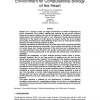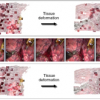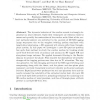112
click to vote
TMI
2010
14 years 5 months ago
2010
As decisions in cardiology increasingly rely on non-invasive methods, fast and precise image processing tools have become a crucial component of the analysis workflow. To the best ...
MIA
2011
14 years 6 months ago
2011
For the last 15 years, Magnetic Resonance Imaging (MRI) has become a reference examination for cardiac morphology, function and perfusion in humans. Yet, due to the characteristic...
104
click to vote
BCS
2008
15 years 19 days ago
2008
Despite over a century's study, the trigger mechanisms of cardiac arrhythmias are poorly understood. Even modern experimental methods do not provide sufficient temporal and s...
116
click to vote
MICCAI
2009
Springer
15 years 3 months ago
2009
Springer
Real-time three-dimensional (RT3D) echocardiography is the newest generation of three-dimensional (3-D) echocardiography. Segmentation of RT3D echocardiographic images is essential...
ISBI
2006
IEEE
15 years 5 months ago
2006
IEEE
Quantitative analysis of cardiac motion is of great clinical interest in assessing ventricular function. Real-time 3-D (RT3D) ultrasound transducers provide valuable threedimensio...
152
click to vote
MICCAI
2007
Springer
15 years 5 months ago
2007
Springer
The use of vision based algorithms in minimally invasive surgery has attracted significant attention in recent years due to its potential in providing in situ 3D tissue deformation...
FIMH
2007
Springer
15 years 5 months ago
2007
Springer
Abstract. In this paper, a statistical atlas of DT-MRIs based on a population of nine ex vivo normal canine hearts is compared with a human cardiac DT-MRI and a commonly used synth...
ISBI
2007
IEEE
15 years 5 months ago
2007
IEEE
Quantitative analysis of cardiac motion is of great clinical interest in assessing ventricular function. Real-time 3-D (RT3D) ultrasound transducers provide valuable fourdimension...
104
click to vote
SCALESPACE
2009
Springer
15 years 5 months ago
2009
Springer
Abstract. The dynamic behavior of the cardiac muscle is strongly dependent on heart diseases. Optic flow techniques are essential tools to assess and quantify the contraction of t...



